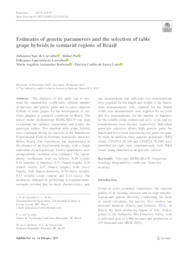Estimates of genetic parameters and the selection of table grape hybrids in semiarid regions of Brazil.
Estimates of genetic parameters and the selection of table grape hybrids in semiarid regions of Brazil.
Author(s): CARVALHO, J. N. de; PIO, R.; CARVALHO, P. A. de; BARBOSA, M. A. G.; LEAO, P. C. de S.
Summary: The objective of this study was to estimate the repeatability coefficients, optimal number of harvests, and genetic gains and to select superior hybrids of table grapes for the development of cultivars adapted to semiarid conditions in Brazil. The mixed model methodology REML/BLUP was used to estimate the variance components and predict the genotypic values. Two hundred table grape hybrids were evaluated during six harvests at the Mandacaru Experimental Field in Embrapa Semiárido, Juazeiro, Bahia, Brazil. The experiment was implemented in the absence of an experimental design, with a single individual of each genotype. Twelve quantitative morphoagronomic variables were evaluated. The repeatability coefficients were as follows: 0.20 (yield), 0.18 (number of bunches), 0.37 (bunch length), 0.30 (bunch width), 0.47 (bunch weight), 0.60 (berry length), 0.68 (bunch diameter), 0.70 (berry weight), 0.14 (soluble solids content) and 0.13 (ratio). The accuracies obtained by performing m repeated measurements revealed that for berry characteristics, only one measurement was sufficient; two measurements were required for the length and weight of the bunch; three measurements were required for the bunch width; four measurements were required for the yield and five measurements for the number of bunches; for the soluble solids content and ratio, seven and six measurements were needed, respectively. Individual genotypic selection allows high genetic gains for bunch and berry traits and satisfactory gains for quality traits. In addition, three superior genotypes (?BRS Tainá?, CPATSA 05.168 and CPATSA 79.100) wereidentified for eight traits simultaneously, with ?BRS Tainá? being identified as an apyrenic cultivar.
Publication year: 2023
Types of publication: Journal article
Unit: Embrapa Semi-arid Region
Observation
Some of Embrapa's publications are published as ePub files. To read them, use or download one of the following free software options to your computer or mobile device. Android: Google Play Books; IOS: iBooks; Windows and Linux: Calibre.
Access other publications
Access the Agricultural Research Database (BDPA) to consult Embrapa's full library collection and records.
Visit Embrapa Bookstore to purchase books and other publications sold by Embrapa.

